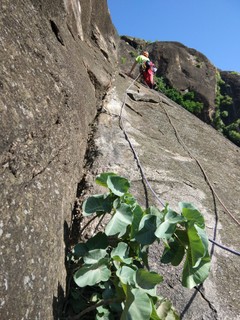Seasonality
Summary
Description
This huge rock has many potential lines and an easy hike down following a service road that supplies the tiny military base on the top of the rock. As of 2018, only two lines (13 and 10 pitches) had been established.
During rainy season, or after any rain at all, these routes can be impassable. Mt. Oret dries out slowly and these routes in particular can take days to dry out after a rain.
©Access issues
Access is free and the local community is friendly. You may need to pay a few shillings to park near the rock and to have someone look after your car. Make sure to ask a local for permission and agree on a price beforehand if possible. We paid 2k for a day's parking. Once you reach the top of the rock, the soldiers might threaten to arrest you. So far, climbers have just been friendly with the soldiers, shared some stories, showed and explained our gear, shared a few snacks and laughs with the UPDF men on top of Oret and walked away without much hassle.
After the hike down, you can grab a boda boda to retrieve your car. After dark, locals might be drunk and therefore quite pushy for exorbitant parking fees. Possibly just park at your guest house and hike to the base or retrieve your car earlier in the daytime when folks are more likely to be reasonable.
©Approach
Park on the back side of the sprawling Kalongo Hospital complex as near to the rock as you can find, which is next to some huts. Hike up the bush to the base from there. There is no trail and it can be quite bushy and steep. Should take 30 mins or so.
Maybe wear long sleeves and pants on this one. The approach can be thorny and the rock is pretty sun exposed. You might see a snake or two along the approach and lower pitches.
©Where to stay
Ethic
Very few climbers have enjoyed these rocks over the years, but the potential is immense. Please do climbers a favor and work to cultivate a positive image of climbers in this area.
©History
Mt. Oret was first trad climbed in 2015 by Emmanuel Fredenthal and Luke Hodgkinson. Since then, a handful of climbers have summited this. The nearby rocks of Rwot and Amiel were first climbed in the late 50s and early 60s. However, the old guidebooks from 1962/3 and 1991 leave no mention of anyone climbing Mr. Oret or Kilibi.
©Plan your Trip
Some content has been provided under license from: © Matt Battani (Matt Battani)
Did you know?
Did you know that you can create an account to record, track and share your climbing ascents? Thousands of climbers are already doing this.
Get a detailed insight with a timeline showing
- Ticks by climbers like you
- Discussions of the community
- Updates to the index by our users
- and many more things.
Login to see the timeline!





